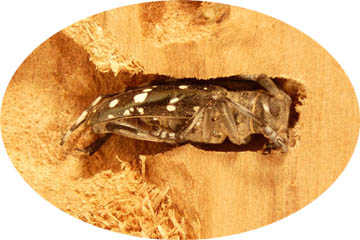
 |
Asian
Longhorned Beetle
|
 |
|
Management
|
| Prevention
|
 |
Survey and Detection |
| Introduction
As of January 2001 the Asian longhorned beetle (ALB) is known to have infested trees only in the areas in and around New York City (and a few towns on Long Island) and Chicago, IL. (see USFS maps) It is not known to be infesting trees anywhere else in the US. However, live beetles have been found at the ports and in warehouses in several different states (view map - PDF). Action is underway to eradicate this pest from our country. Surveys are being done to detect any and all infested trees in and around infested areas, so that tree removal and replanting can be completed quickly. Efforts are also ongoing to prevent future infestations. Public awareness is a key to detect infestations early, and educational programs on a local, regional and national scale have been implemented. In addition, an extensive research initiative has begun to improve survey and detection methods and develop effective methods of management should eradication prove unsuccessful. Many states where ALB has not been found have developed Action Plans so that they will be able to take prompt action to eliminate the beetle from their areas. Can We Live With The Asian Longhorned Beetle? Why Eradication? Because ALB was a new exotic pest in this country when it was found infesting trees in New York in 1996, the US Dept. of Agriculture, Animal Plant Health Inspection Service, Plant Protection and Quarantine (USDA-APHIS-PPQ) was identified as the primary responsible agency to address this potential pest. According to standard federal procedures, a New Pest Advisory Group was appointed to evaluate the seriousness of this problem. Based on the findings of this group, a Science Advisory Panel, made up of scientists and pest specialists from the USDA and universities in New York and Vermont, was appointed to develop specific technical means for controlling ALB. In addition, a joint state/local/federal operational team was organized to implement and manage an ALB control or eradication program. |